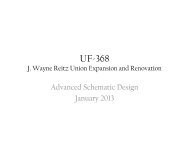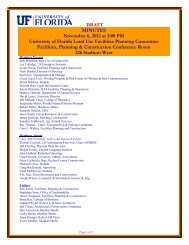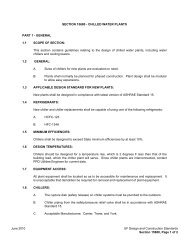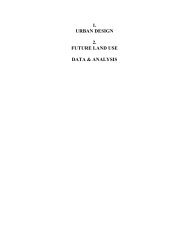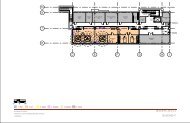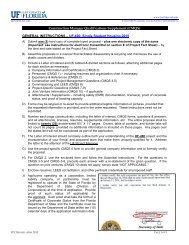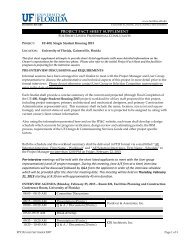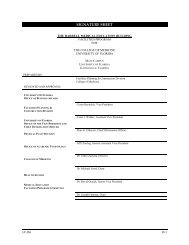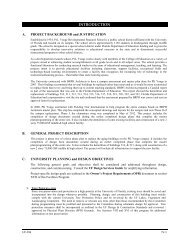Owner's Project Requirements (OPR) - UF-Facilities Planning ...
Owner's Project Requirements (OPR) - UF-Facilities Planning ...
Owner's Project Requirements (OPR) - UF-Facilities Planning ...
You also want an ePaper? Increase the reach of your titles
YUMPU automatically turns print PDFs into web optimized ePapers that Google loves.
Owner’s <strong>Project</strong> <strong>Requirements</strong> (<strong>OPR</strong>)<br />
17.1 Introduction<br />
17.2 Owner <strong>Requirements</strong> Covered Elsewhere<br />
17.3 <strong>Project</strong>-Specific Design Goals<br />
17.4 Occupancy & Use<br />
17.5 Sustainability and Energy Efficiency<br />
17.6 Building Site<br />
17.7 Transportation & Parking<br />
17.8 Building Envelope<br />
17.9 Indoor Environmental Quality<br />
17.10 Emergency or Backup Power<br />
17.11 Telecommunications and A/V Systems<br />
17.12 Security<br />
17.13 Hazardous Materials<br />
17.14 Furnishings & Equipment<br />
17.15 Commissioning, Inspection, and Q.A.<br />
17.16 Construction Completion & Turnover<br />
17.17 Operation & Maintenance<br />
17.18 Owner Training<br />
17.19 Post-Occupancy and Warranty<br />
17.1 INTRODUCTION<br />
Along with the other sections of this <strong>Facilities</strong> Program, this Owner’s <strong>Project</strong> <strong>Requirements</strong> (<strong>OPR</strong>)<br />
document outlines functional requirements of the project and expectations of how the facility and its<br />
systems will be used and operated. The <strong>OPR</strong> is required for LEED certification of the project, but also<br />
serves three broader vital purposes:<br />
1. Provides the design team with information necessary to develop the Basis of Design (BOD) during<br />
program verification and/or schematic design, which serves as a “road map” for development of the<br />
design and construction documents.<br />
2. Provides the commissioning (Cx) team with tangible benchmarks to measure success & quality and<br />
confirm that the building and systems constructed align with the University’s expectations and<br />
requirements.<br />
3. Serves, along with the BOD and contractor deliverables such as “as-built” documents, as the<br />
foundation for the Systems Manual outlined below.<br />
The Owner will develop and update the <strong>OPR</strong> until the Cx consultant is selected. The Cx consultant will<br />
then assume responsibility for refining and augmenting the <strong>OPR</strong> throughout design, construction, and the<br />
post-occupancy period of one year following Substantial Completion of construction. As decisions are<br />
made during the life of the project, this document shall be updated to reflect the current requirements of<br />
the University.<br />
The Owner is the University of Florida Board of Trustees (<strong>UF</strong>). Primary users and stakeholders include<br />
the Office of the Vice President for Student Affairs, J. Wayne Reitz Union, Center for Leadership &<br />
Service, Counseling & Wellness Center, Multicultural & Diversity Affairs, Student Activities &<br />
Involvement, Student Government, students, staff, alumni and visitors. The entity responsible for project<br />
management and delivery is <strong>UF</strong> <strong>Facilities</strong> <strong>Planning</strong> and Construction (FPC). The organization<br />
responsible for operation and maintenance of the facility is JWRU Operations with support from Physical<br />
Plant Division (PPD).<br />
<strong>UF</strong>-368 XVII-1
Owner’s <strong>Project</strong> <strong>Requirements</strong> (<strong>OPR</strong>)<br />
17.2 OWNER REQUIREMENTS COVERED ELSEWHERE<br />
Many components of, or related to, the <strong>OPR</strong> are covered elsewhere in the <strong>Facilities</strong> Program, including:<br />
Detailed project history, background, and justification – Section IV<br />
General planning and design objectives – Section IV<br />
Relationship to Campus Master Plan – Section VII<br />
Existing site conditions & constraints – Section VIII<br />
<strong>Project</strong> space types, sizes, and adjacencies – Section IX<br />
Finishes, M/E/P, telecomm and A/V, and acoustic requirements by space or space type – Section IX<br />
Distributed and site underground utilities – Section X<br />
Applicable codes – Section XII<br />
<strong>Project</strong> schedule and budget – Sections XIII and XV<br />
Additional requirements, expectations, and standards for <strong>UF</strong> projects are detailed in the following:<br />
<strong>UF</strong> Design & Construction Standards – www.facilities.ufl.edu<br />
<strong>UF</strong> Telecommunications Standards – http://net-services.ufl.edu/infrastructure/<br />
Design Services Guide – www.facilities.ufl.edu<br />
<strong>UF</strong> Energy Policies, Rates, Provisions – www.ppd.ufl.edu/pdf/<strong>UF</strong>UtilityPolicy.pdf<br />
<strong>UF</strong> Environmental Health & Safety – www.ehs.ufl.edu<br />
17.3 PROJECT-SPECIFIC DESIGN GOALS (from Program IV)<br />
1. Flexibility and Future Expansion<br />
The Student Union is an ever changing building and interior spaces shall be designed to facilitate<br />
reconfiguration as needed to meet changing needs with minimal renovation work, including<br />
mechanical, electrical and telecommunications infrastructure.<br />
The Student Union is envisioned to be state of the art with IT technology and to have a design<br />
which will allow for easy adaptation to newer technologies.<br />
2. Quality and Context<br />
The site is at the heart of the University and is one of the few buildings which every student,<br />
parent and alumni will at some point enter.<br />
There are many different architectural aesthetics in the area and the building needs to stand on its’<br />
own, while complementing the surrounding buildings.<br />
The building is envisioned to be a transparent building which is welcoming and allows students to<br />
see what is happening inside and gives them an opportunity to become involved.<br />
The building will become the University “living room” and as such should convey a feeling of<br />
welcome, warmth and a place to meet friends. We do not want a building which photographs<br />
well, but is a cold aesthetic with the result that the student do not want to hang out at the Union.<br />
The existing Union has no “there” there. When asked to meet at the Union – we want to provide<br />
a location which is the obvious front door.<br />
Interior spaces must provide a superior indoor environment to facilitate occupants’ comfort and<br />
productivity with high indoor air quality, proper acoustics and no moisture intrusion.<br />
The building shall emphasize University of Florida traditions and its’ Florida heritage and be<br />
designed such that this building could only be located at the University of Florida.<br />
3. Expect part of this new building to be designed and used as an Emergency Shelter.<br />
4. The University of Florida prides itself on our sustainability and the students expect sustainability to<br />
be at the forefront of design. This is the Student Union and shall be exemplary in the implementation<br />
of sustainable design.<br />
5. This building shall be LEED Platinum<br />
<strong>UF</strong>-368 XVII-2
Owner’s <strong>Project</strong> <strong>Requirements</strong> (<strong>OPR</strong>)<br />
6. This building is being considered for the Living Building Challenge and as a Net Zero Energy<br />
Building<br />
7. We are assuming that this building will contain an atrium and as such, shall comply with all code<br />
requirements.<br />
8. All design, construction and closeout process shall fully employ Building Information Modeling<br />
(BIM) technology and strategies to reduce construction conflicts, improve efficiencies, and allow for<br />
production of accurate and fully data-loaded (“smart”) record model(s) of the new facility.<br />
17.4 OCCUPANCY & USE<br />
The hour of operation for the Union varies depending on the time of year. Typically it is open from 7:00<br />
AM – 3:00 AM with longer hours during finals week.<br />
Describe the occupants - number, type, transient vs. permanent, etc.<br />
Elaborate on any other special occupancy or usage goals, requirements ...<br />
17.5 SUSTAINABILITY and ENERGY EFFICIENCY<br />
As part of an overall commitment to sustainability and a goal of achieving “carbon neutrality” by the year<br />
2025, the University of Florida builds its facilities to last and promotes environmental quality and<br />
resource conservation through sustainable design and construction. See www.sustainable.ufl.edu.<br />
As part of that commitment and to demonstrate that the facility was designed and constructed to be<br />
energy-efficient and environmentally sustainable, University projects must be certified by the U.S. Green<br />
Building Council (USGBC) through its Leadership in Energy and Environmental Design (LEED) process.<br />
See www.usgbc.org and www.facilities.ufl.edu/sustain.<br />
This project shall achieve LEED-BD&C certification at no lower than Platinum level. Specific, highpriority<br />
goals for this project include:<br />
Maximization of the HVAC credits under the Energy and Atmosphere section of the LEED rating<br />
system as a first priority. The facility shall operate at a minimum of 40% higher efficiency than<br />
ASHRAE Standard 90.1-2007.<br />
Incorporation of strategies, measures, and systems to conserve energy, such as heat/enthalpy wheels,<br />
energy recovery units, “setback” modes, etc.<br />
Utilization of the Building Automation System and other controls to efficiently maintain and track<br />
performance of key building systems, particularly HVAC and lighting. See <strong>UF</strong> Design &<br />
Construction Standard 15950.<br />
Optimization of air conditioning systems for maximum building efficiency<br />
Use of low-VOC, regionally-available, and high recycled content materials.<br />
Adoption of “daylight harvesting” to minimize electric lighting usage where functionally practical.<br />
Incorporation of solar energy techniques, strategies and products.<br />
Utilization of FSC-certified wood<br />
Utilization of Florida products<br />
Use of LED exterior lights<br />
Florida friendly landscape<br />
A comprehensive Measurement & Verification Plan that allows for capturing, calculating and<br />
reporting relevant energy use data and performance verification of energy conservation measures.<br />
<strong>UF</strong>-368 XVII-3
Owner’s <strong>Project</strong> <strong>Requirements</strong> (<strong>OPR</strong>)<br />
An interactive public “dashboard” capable of displaying predicted and actual energy usage, costs and<br />
other performance metrics.<br />
The team will help determine if the new facility will be on the <strong>UF</strong> Chilled Water loop, or if <strong>UF</strong> will<br />
attain a higher energy efficiency through VRF, chilled beams, geo-thermal or another technology.<br />
The Basis of Design (BOD) shall establish specific plans and strategies for achieving these goals, and the<br />
construction documents shall include requirements for LEED submittals and sustainable construction<br />
practices and techniques, including:<br />
Segregated collection and recycling of construction waste<br />
Proper erosion and sedimentation control techniques<br />
Procurement and use of low-VOC, regionally-available, and high recycled content materials<br />
The BOD shall also address the USGBC document entitled “Required Treatment of District Thermal<br />
Energy in LEED-NC” (5/22/08) and its applicability to LEED certification of this project.<br />
The enclosed LEED matrix provides the University’s pre-design estimate of the probability of securing<br />
each credit – high, medium, or low. During program verification and/or conceptual schematic design, the<br />
project team will review and update this spreadsheet in order to firmly establish sustainability goals for<br />
the project. The matrix will be continuously maintained by the University throughout design and<br />
construction as a guideline for achieving LEED certification and tracking progress and action items.<br />
Progress Energy – the University’s primary electric and steam provider – has established a rebate<br />
program for certain components of new construction that meet energy efficiency requirements, including:<br />
lighting<br />
compressed air system<br />
motors<br />
high efficient chillers<br />
energy recovery ventilation<br />
occupancy sensors<br />
solar, green, or cool roofs<br />
thermal energy storage<br />
demand control ventilation<br />
To verify compliance and confirm which rebates apply to this project, Progress Energy will review the<br />
100% Construction Documents and final energy model and will inspect the building at completion.<br />
Specific portions of the final MEP drawings/schedules, energy model, and other information will be used<br />
by Progress Energy to perform calculations necessary to determine the rebate for each project. The<br />
University expects all components of this project/building to be the most efficient and highest quality<br />
systems in order to qualify for these rebates.<br />
17.6 BUILDING SITE<br />
See section VIII of the <strong>Facilities</strong> Program.<br />
The site location will be challenging from a design and construction standpoint as there is no easy access<br />
or laydown area. Student, staff and visitor safety shall be a priority.<br />
The existing building shall remain open throughout the entire construction duration. Both the design and<br />
construction phasing shall take this into consideration.<br />
<strong>UF</strong>-368 XVII-4
Owner’s <strong>Project</strong> <strong>Requirements</strong> (<strong>OPR</strong>)<br />
17.7 TRANSPORTATION & PARKING<br />
The existing transportation & Parking infrastructure will not change with this building. Currently, there is<br />
a parking garage for visitors attached to the existing building, a surface lot across the street, a major bus<br />
hub next to the Union, a major bike parking area and many pedestrians.<br />
The existing bike lot will need to be relocated and expanded.<br />
Refer to the Master Plan regarding pedestrian and bike corridors around the site.<br />
17.8 BUILDING ENVELOPE<br />
The exterior shall be designed to endure for at least 75 years. Selection of materials and detailing of<br />
envelope systems shall be consistent with the Florida Building Code and <strong>UF</strong> Design & Construction<br />
Standards; performance-based to allow the building to withstand weather conditions typical of North<br />
Central Florida; and esthetically consistent with the area of campus where the facility will be constructed.<br />
We will be replacing many of the windows in the existing building to help with energy conservation and<br />
water intrusion. Prevention of moisture intrusion is a high-priority goal applicable to all project team<br />
disciplines.<br />
Solar transmission shall be controlled and designed in accordance with ASHRAE Standard 90.1-2004<br />
through high-performance, low-e glazing, overhangs, reflective “cool roof” materials and external<br />
shading, and other techniques to minimize solar heat gain and maximize light transmittance for<br />
daylighting where functionally practical. Spaces in this building where daylighting is not functionally<br />
practical include:<br />
Rion Ballroom<br />
Roofs shall have a minimum reflectivity of 0.30 to reduce solar heat gain.<br />
17.9 INDOOR ENVIRONMENTAL QUALITY<br />
1. Indoor Lighting and Lighting Controls<br />
Although lighting controls are encouraged, a physical light switch is needed in each space.<br />
Lighting controls shall be simple and easy to maintain, but possibly integrated with the Building<br />
Automation System at least for M&V reporting.<br />
All common spaces shall have heat and/or motion sensor lighting controls<br />
Analyze the viability of daylight harvesting in large, open public spaces<br />
Where appropriate, T-5 fluorescent lamps shall be used<br />
2. Thermal Comfort<br />
From the <strong>UF</strong> Energy Policy re: heating and cooling set points:<br />
In order to optimize energy consumption through the different seasons, there shall be a<br />
temperature set-point of 70˚ F when outside air temperature is 65˚ F or below, and 76˚ F<br />
when outside air temperature is above 65˚ F. If the air conditioning system incorporates<br />
a de-humidification sequence of operation, to avoid excess re-heating, the temperature<br />
set point may be decreased to 74˚ instead of 76˚. These set-points will have an<br />
acceptable tolerance of +/- 2˚ F. Temperatures will be set either through the building<br />
automation system or at the thermostat.<br />
<strong>UF</strong>-368 XVII-5
Owner’s <strong>Project</strong> <strong>Requirements</strong> (<strong>OPR</strong>)<br />
Thermostat dead-bands identified in the ASHRAE 55.1 will be utilized. Buildings will be<br />
positively pressurized with relative humidity levels of 60% or below.<br />
Exemptions to this policy include maintaining laboratory plants or animal life, operation<br />
of data processing or other equipment which is temperature sensitive, storage of food or<br />
other perishables for research purposes, and preservation of archives, books, art works<br />
or specimen. Written requests for exemptions should be sent by the Department<br />
Administrator to the EMT, and signed by the VP for Business Affairs.<br />
Provide HVAC to all A/V control rooms and closets<br />
Provide user/occupant controls in all normally occupied spaces that offer a +/- 2 degree range of<br />
control.<br />
3. Ventilation and Filtration<br />
As required by FL Building Code, <strong>UF</strong> Design & Construction Standards, LEED, and other<br />
governing standards.<br />
As required for all cooking applications.<br />
4. Acoustics<br />
Confirm STC and NC ratings for ALL space types during program verification and incorporate<br />
systems, products, and strategies as needed to meet or exceed these standards, including floor-todeck<br />
interior partitions for reduced sound transmission between acoustically-sensitive spaces,<br />
STC-rated doors, and HVAC sound attenuation strategies.<br />
Acoustically separate all restrooms from adjacent spaces and do not place restrooms adjacent to<br />
classrooms or study spaces.<br />
5. Other Owner <strong>Requirements</strong><br />
Daylighting and views<br />
Vibration criteria<br />
Pre and post occupancy IAQ tests will be performed by <strong>UF</strong> Environmental Health & Safety<br />
(EH&S).<br />
17.10 EMERGENCY, BACKUP, or ‘CLEAN’ POWER<br />
Emergency Power will need to be provided. The amount and locations will be coordinated with<br />
the building occupants, EH&S and the State Emergency Shelter team.<br />
17.11 TELECOMMUNICATIONS and AUDIO/VISUAL SYSTEMS<br />
Telecommunications<br />
Provide wireless access throughout the building<br />
Provide ample I/T and A/V pathways throughout to allow for growth, flexibility, and greater<br />
technological demands<br />
Provide network drops for Owner-furnished mass emergency notification (IP) speakers<br />
Also provide network drops for Owner-furnished web-based security cameras<br />
Owner-furnished VOIP telephone handsets will be used throughout the facility<br />
<strong>UF</strong>-368 XVII-6
Owner’s <strong>Project</strong> <strong>Requirements</strong> (<strong>OPR</strong>)<br />
In order to ensure sufficient time for Commissioning, the Division 17 specifications for voice/data<br />
systems and work shall stipulate that all network infrastructure, structured cabling, and other<br />
telecommunications work be completed at least 45 days prior to Substantial Completion<br />
One standard (240 SF) telecomm room (TR) is programmed, but additional satellite TRs shall be<br />
provided as needed<br />
See Section IX of the <strong>Facilities</strong> Program for specific room-by-room requirements<br />
Confirm during Program Verification or Schematic Design whether or not the TR(s) will be outfitted<br />
by others under the direction of <strong>UF</strong> OIT<br />
Refer to the March 2011 <strong>UF</strong> Telecommunications Standards and Sections X and XI of the <strong>Facilities</strong><br />
Program for more information on voice/data cabling and infrastructure, TRs, wireless access, and<br />
other components and requirements<br />
Audio/Visual<br />
Provide flat-screen (LED/LCD) monitors with network connection to playback gear or digital signage<br />
software and/or CATV throughout the facility … in office reception areas, collaboration spaces,<br />
student study lounges, lobby/entry areas, etc.<br />
Link all A/V control rooms and closets together with conduit & cabling so A/V signals can be sent<br />
from any source to any destination (monitor, speakers, or other playback device)<br />
Ensure coordination of lighting and A/V design and installation/integration<br />
See Section IX of the <strong>Facilities</strong> Program for specific room-by-room requirements<br />
Also see section XI of this facilities program.<br />
17.12 SECURITY<br />
Access controls systems - including card or proximity readers – shall restrict access into certain<br />
rooms and otherwise record traffic in same; system shall be Lenel brand and shall be designed in<br />
accordance with the <strong>UF</strong> Design & Construction Standards<br />
Provide additional wall-mounted or ceiling-mounted network drops for IP-based security cameras as<br />
needed.<br />
17.13 HAZARDOUS MATERIALS<br />
Existing<br />
A survey of the existing building will be completed by <strong>UF</strong>.<br />
17.14 FURNISHINGS & EQUIPMENT<br />
Owner-Furnished, Owner-Installed F&E<br />
Network electronics (telecomm room)<br />
Permanent door cylinders & keys<br />
IP speakers for emergency notification<br />
Computers & office machines<br />
Kitchen appliances<br />
Certain fixtures/equipment in food service<br />
Contractor-Furnished, Contractor-Installed F&E<br />
Casework & millwork<br />
Access control equipment<br />
Telephone handsets<br />
Moveable furniture<br />
Signage<br />
Security cameras<br />
Certain toilet accessories<br />
Audio/visual equipment<br />
<strong>UF</strong>-368 XVII-7
Owner’s <strong>Project</strong> <strong>Requirements</strong> (<strong>OPR</strong>)<br />
See Section IX of the <strong>Facilities</strong> Program for detailed, space-by-space information.<br />
17.15 COMMISSIONING, INSPECTION, and QUALITY ASSURANCE<br />
The Commissioning (Cx) consultant will be independent of the design and construction teams, will be<br />
selected by the ASD phase, and will be responsible for maintenance of this <strong>OPR</strong>; peer review of the<br />
design and construction documents; development of the project-specific Cx specification using the<br />
University’s template “non-technical” spec; development of the project-specific Cx Plan; construction<br />
and acceptance phase commissioning and documentation; development of the facility’s Systems Manual;<br />
and post-occupancy commissioning, testing, and documentation.<br />
It is anticipated that the following building systems will be commissioned:<br />
Mechanical and HVAC systems<br />
Electrical and lighting systems<br />
Domestic hot water systems<br />
Building envelope systems<br />
Renewable energy systems<br />
The following items of particular interest to the University shall be addressed and verified by the Cx<br />
consultant throughout the term of service:<br />
1. Meeting or exceeding “Delta-T” minimums across cooling coils for campus chilled water, if used<br />
2. Accuracy of utilities metering and integration of same with the Building Automation System (BAS)<br />
3. Measurement & Verification of energy usage, performance, and efficiency<br />
Onsite inspection of life safety, code compliance, and ADA-related items will be conducted by the<br />
University’s Division of Environmental Health & Safety (EH&S) and the State Fire Marshal. See<br />
www.ehs.ufl.edu for more information.<br />
Onsite inspection of systems and components governed by the <strong>UF</strong> Design & Construction Standards and<br />
the <strong>UF</strong> Telecommunications Standards. The detailed scope of Cx services shall complement these<br />
inspections to eliminate gaps or “double coverage” in field oversight.<br />
The facility is anticipated to be a “threshold” building as defined by the FL Building Code. The<br />
University will hire a qualified “special inspector” directly or as an additional design service to perform<br />
the onsite inspection and oversight services required for such “threshold” facilities.<br />
The distributed utilities system employed on the main <strong>UF</strong> campus may necessitate partial commissioning<br />
of the energy plant(s) serving the renovated facility and/or collection of energy efficiency data from PPD.<br />
See the USGBC document entitled “Required Treatment of District Thermal Energy in LEED-NC,” dated<br />
5/22/08.<br />
17.16 CONSTRUCTION COMPLETION and TURNOVER<br />
Inspection, testing, and commissioning culminate in a declaration of Substantial Completion by <strong>UF</strong>.<br />
This date establishes both the beginning of the warranty period and commencement of operation and<br />
maintenance by <strong>UF</strong>. Move-in of occupants and their personal belongings will not take place until all<br />
Substantial Completion “punch list” items are completed.<br />
The A/E shall develop a project-specific “closeout deliverables matrix” (using the <strong>UF</strong> template) to<br />
document exactly what is to be required in the specifications for O&M documents, Owner training,<br />
attic stock, warranties, and other deliverables at the end of construction.<br />
<strong>UF</strong>-368 XVII-8
Owner’s <strong>Project</strong> <strong>Requirements</strong> (<strong>OPR</strong>)<br />
<strong>UF</strong> wishes to capture as much relevant and usable information on building products, equipment,<br />
systems, and materials in the “as-built” Building Information Model (BIM) as possible. See projectspecific<br />
BIM Execution Plan and Level Of Detail table, but the A/E shall ensure its specifications<br />
require the submission of Revit-compatible “drop-ins” for installed products, equipment, systems, and<br />
materials as available.<br />
Details on the closeout of major projects can be found on the FPC website.<br />
It is envisioned that the new building will be constructed first, obtain Substantial Completion and<br />
Final Completion and then occupants will move out of the existing building. At this point, the<br />
renovations to those spaces will commence. Therefore, there will be more than one SC and FC for<br />
this project.<br />
17.17 OPERATION & MAINTENANCE<br />
The entity responsible for maintenance and operation of the building and its systems, beginning on the<br />
date of Substantial Completion, is JWRU Operations and PPD.<br />
In addition to the Cx Plan, field reports, and test reports, the Cx consultant’s primary deliverable is a<br />
Systems Manual as required for LEED E/A Credit 3 (Enhanced Commissioning). This manual provides<br />
the University with a single source of information and instructions for proper operation and maintenance<br />
of primary building systems. As opposed to equipment-oriented “O&M manuals,” the Systems Manual is<br />
to be systems-oriented to provide operators with easy access to both narrative and technically detailed<br />
reference material, descriptions, diagrams, schedules, and other information on stand-alone and,<br />
particularly, integrated systems.<br />
Like the <strong>OPR</strong> and BOD, the Systems Manual should be a living document. Unlike the <strong>OPR</strong> and BOD,<br />
though, the Systems Manual should evolve throughout the life of the building – complied by the Cx from<br />
documentation developed by the owner, design team, contractors, and the Cx process itself, then turned<br />
over for perpetual use and upkeep by building operators and future consultants and contractors throughout<br />
the building's life.<br />
17.18 OWNER TRAINING<br />
Onsite training for the Owner – whether operators/maintainers or users/occupants – shall include a<br />
description and overview of systems, not just the components and equipment that comprise each system.<br />
Training – which is ideally held in conjunction with commissioning – should include general orientation<br />
and reviews of the written O&M instructions, relevant health and safety issues or concerns, operation in<br />
all possible modes, preventive maintenance, and common troubleshooting problems & solutions.<br />
Building systems that the maintenance entity and occupants/users shall be trained on include:<br />
HVAC systems<br />
BAS/controls<br />
Electrical systems<br />
Lighting controls<br />
Security systems<br />
Fire Alarm systems<br />
Audio / Visual systems<br />
Most training shall be completed prior to Substantial Completion, and all sessions shall be videotaped and<br />
converted to DVD format for the Owner’s use.<br />
<strong>UF</strong>-368 XVII-9
Owner’s <strong>Project</strong> <strong>Requirements</strong> (<strong>OPR</strong>)<br />
17.19 POST-OCCUPANCY and WARRANTY<br />
The Cx consultant, CM/GC, and all subcontractors whose systems were commissioned shall meet with<br />
the Owner’s O&M staff quarterly during the first year after Substantial Completion to offseason test,<br />
optimize, and otherwise troubleshoot all commissioned systems.<br />
Also, an onsite meeting will be conducted 10-11 months after Substantial Completion to review<br />
performance and quality of the facility with all effected parties – <strong>UF</strong> occupants & users, O&M staff, the<br />
design team, and the contractor and its subcontractors.<br />
<strong>UF</strong>-368 XVII-10



